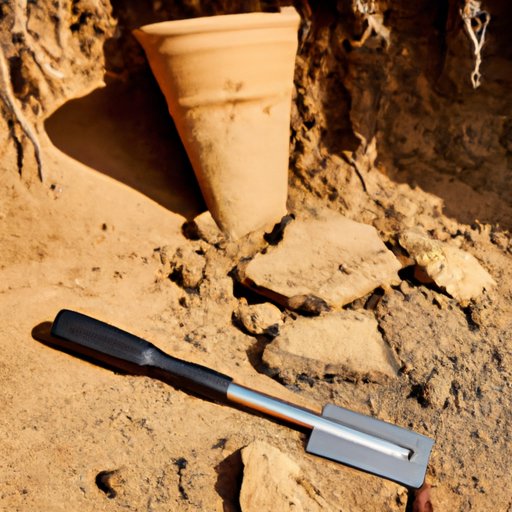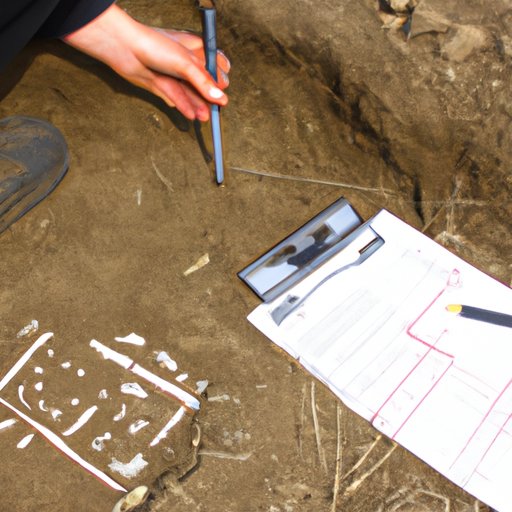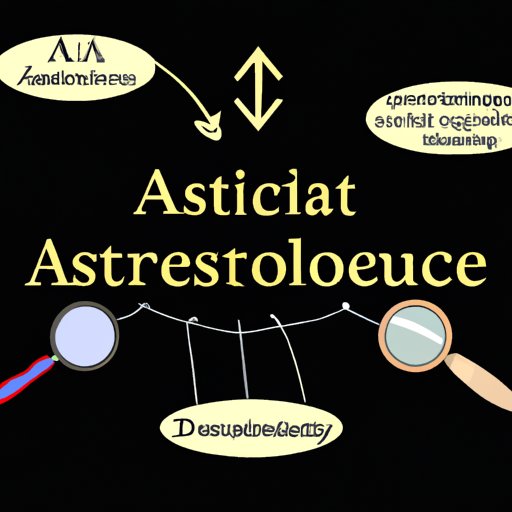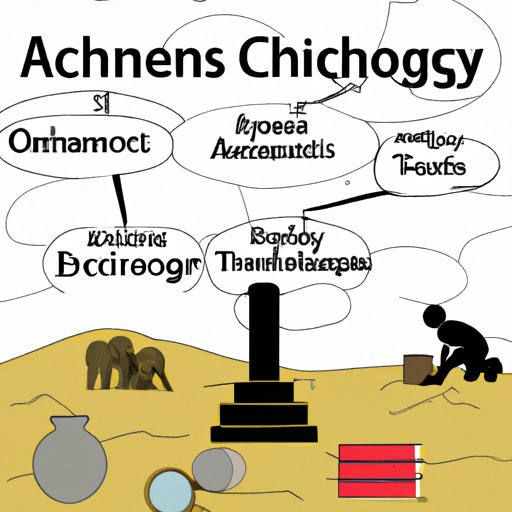Introduction
Archaeology is an exciting field that offers a unique perspective on the past. It has long been a source of fascination for researchers and the public alike, but there has always been some debate about whether it should be considered a science. In this article, we will explore the question of whether archaeology is a science by examining the definition of science and how it applies to archaeological research. We will also look at the benefits, challenges and controversies associated with the field, as well as the relationship between archaeology and other scientific fields and history.

Examining the Definition of Science and How it Relates to Archaeology
The definition of science can vary depending on who you ask, but generally speaking, it is a systematic method of studying the natural world through observation and experimentation. It relies on evidence-based conclusions and is focused on discovering facts rather than opinions. When it comes to archaeology, the definition of science becomes more complicated.
Archaeology is often seen as a hybrid of both science and humanities, as it combines elements of both disciplines. While it does involve the study of material remains, it also relies heavily on interpretation and theories, which are not necessarily scientific in nature. Therefore, it can be difficult to determine whether archaeology meets the criteria to be classified as a science or not.
In order to assess the status of archaeology as a science, it is important to consider the characteristics of science. These include objectivity, quantification, verification, repeatability, and explanation. Objectivity means that the results of an experiment are independent of the researcher’s opinion or bias. Quantification refers to the use of measurements and numerical data to support conclusions. Verification involves testing hypotheses to ensure their validity. Repeatability means that experiments can be repeated with the same results. Finally, explanation is the ability to explain why something happened or why a certain result was reached.
When looking at these characteristics, it is clear that archaeology can meet many of them. For example, archaeologists use a variety of techniques to gather data and measure artifacts, which demonstrates the use of quantification. They also use scientific principles such as the scientific method to test hypotheses and draw conclusions. Additionally, archaeological findings can often be verified through further research and experimentation, and results can be replicated with similar outcomes.
However, it is important to note that there are some aspects of archaeology that do not fit into the traditional definition of science. For example, interpretation of artifacts and sites is largely subjective and based on the researcher’s own experience and expertise. Additionally, archaeological findings are often open to multiple interpretations, making it difficult to explain why something occurred.

Exploring the Benefits of Archaeology as a Science
Despite the challenges that come with determining the scientific status of archaeology, there are still many benefits to considering it a science. One of the main benefits is access to new technologies and methods. As archaeology is increasingly seen as a science, more resources are becoming available to help researchers in their work. This includes advances in technology such as satellite imaging, ground penetrating radar, and DNA analysis, all of which can provide valuable information and insights into the past.
Another benefit of seeing archaeology as a science is the application of scientific principles. By using the scientific method and other principles, archaeologists are able to conduct experiments and draw conclusions based on evidence. This helps to ensure that their findings are reliable and accurate. Additionally, by using scientific methods, archaeologists can gain a better understanding of the past, which can help us to make sense of our present and future.
Investigating the Role of Theory in Archaeological Research
Theories play an important role in archaeological research. A theory is a set of ideas or explanations about a particular phenomenon. In archaeology, theories are used to explain why certain artifacts, sites, or cultures developed in the way that they did. Different types of theories can be used, such as evolutionary, cultural, or environmental.
Theories can be tested and refined through empirical research, which is another way that archaeology can be seen as a science. For example, archaeologists may use experimental archaeology to replicate ancient processes and test hypotheses. They may also use comparative studies to analyze similarities and differences between various artifacts and cultures. By doing so, they can develop a better understanding of the past and form more accurate theories.
Discussing the Controversy Surrounding the Status of Archaeology as a Science
While there are many benefits to considering archaeology a science, there is also much controversy surrounding its status. Some argue that archaeology should not be seen as a science because it relies too heavily on interpretation and theories. Others point out that many of the techniques used in archaeology, such as stratigraphy and radiocarbon dating, are scientific in nature and should be considered as such.
In addition to the debate over whether archaeology is a science or not, there are also challenges that must be addressed in order for it to be accepted as a scientific field. These include developing better methods of collecting and analyzing data, as well as increasing collaboration between archaeologists and other scientists. Additionally, there needs to be better communication among researchers in order to create a unified body of knowledge.

Investigating the Use of Quantitative Methods in Archaeology
One of the ways that archaeology can be seen as a science is through the use of quantitative methods. Quantitative methods involve the use of mathematical equations and statistical models to analyze data and draw conclusions. These methods are often used to study population patterns, site distributions, and artifact frequencies.
The advantages of using quantitative methods in archaeology are numerous. For one, they allow researchers to process large amounts of data quickly and accurately. Additionally, they can be used to identify patterns and trends that would otherwise be difficult to detect. Finally, quantitative methods provide a more objective approach to analyzing data, which can help to reduce bias and errors in interpretation.
Examples of quantitative methods used in archaeology include Geographic Information Systems (GIS), Bayesian statistics, and agent-based modeling. GIS is used to map archaeological sites and analyze spatial patterns. Bayesian statistics is used to calculate the probability of certain events occurring in the past. And agent-based modeling is used to simulate the behavior of ancient societies.

Analyzing the Relationship Between Archaeology and Other Scientific Fields
Archaeology has much in common with other scientific fields, including biology, chemistry, physics, and geology. Like archaeology, these fields rely on the scientific method and empirical research to draw conclusions. Additionally, many of the techniques used in archaeology, such as radiocarbon dating and DNA analysis, are also used in other sciences.
Despite these similarities, there is still a disconnect between archaeology and other scientific fields. This is mainly due to the fact that archaeology is often seen as a less rigorous form of science. To bridge this gap, it is important for archaeologists to collaborate with other scientists and apply the same standards of evidence and methodology. This will help to increase the credibility of archaeological research and demonstrate its value as a scientific field.
Comparing and Contrasting Archaeology and History
Archaeology and history are often confused as being the same thing, but they actually have quite different approaches and objectives. History is focused on written records and documents, while archaeology is focused on physical remains and artifacts. Historians often use primary sources such as diaries, letters, and newspapers to study the past, while archaeologists rely on secondary sources like pottery, tools, and architecture.
Despite the differences between the two fields, there are also some similarities. Both history and archaeology are interested in uncovering the truth about the past. Additionally, both fields rely on the interpretation of evidence in order to make sense of the data. Finally, both fields strive to answer questions about the past, though the questions asked and the methods used to answer them may differ.
Conclusion
This article has explored the debate surrounding the status of archaeology as a science. We have examined the definition of science and how it applies to archaeology, as well as the benefits, challenges and controversies associated with the field. Additionally, we have looked at the role of theory in archaeological research, the use of quantitative methods, and the relationship between archaeology and other scientific fields and history.
Overall, it is clear that archaeology can meet many of the criteria to be classified as a science. However, there are still some aspects of the field that do not fit into the traditional definition. Ultimately, the debate over whether archaeology is a science will likely continue for some time. But, regardless of the outcome, it is clear that archaeology provides valuable insights into the past and can help us to understand our present and future.
(Note: Is this article not meeting your expectations? Do you have knowledge or insights to share? Unlock new opportunities and expand your reach by joining our authors team. Click Registration to join us and share your expertise with our readers.)
